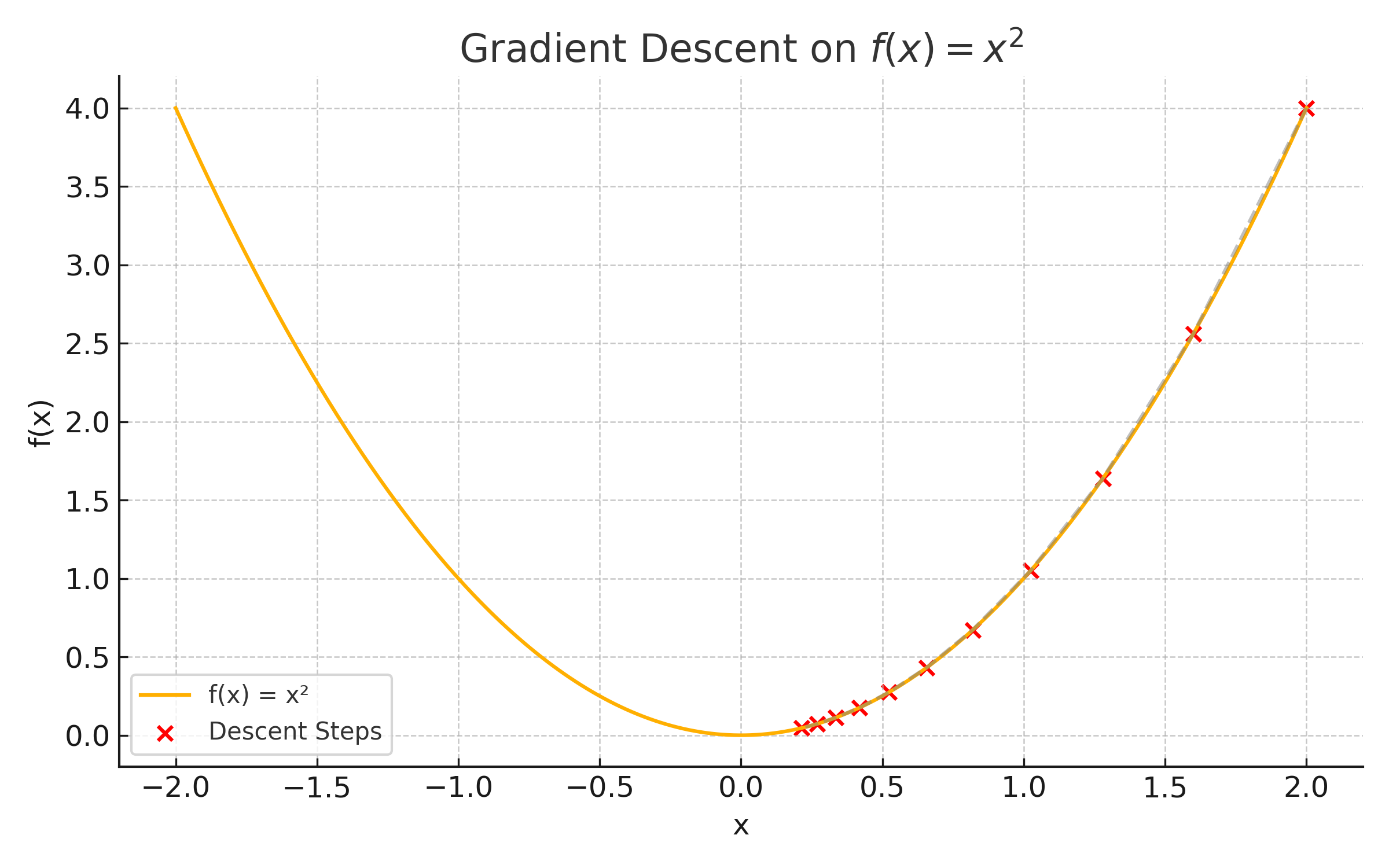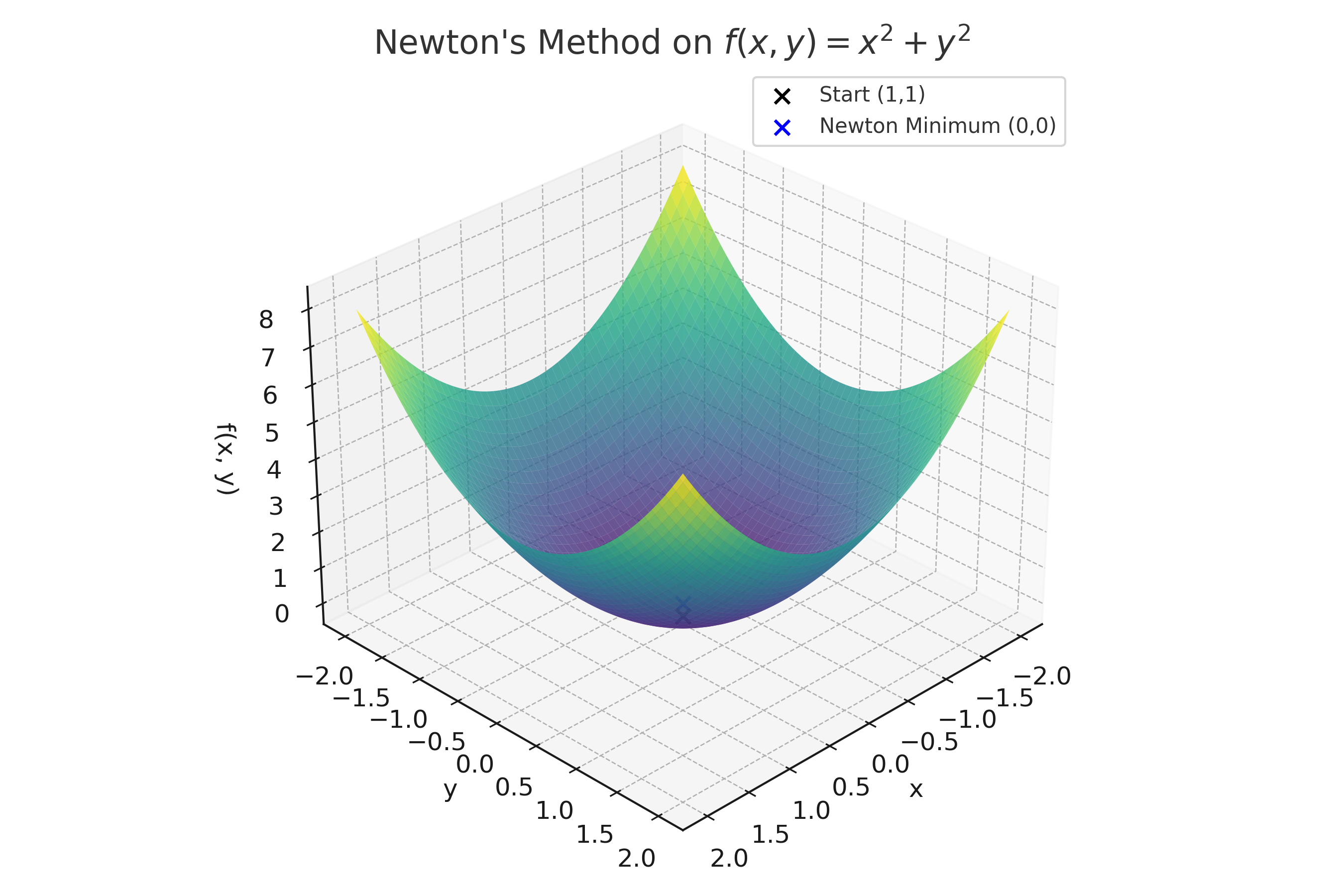⚙️ Optimization in Machine Learning: From Gradient Descent to Newton’s Method
Understand the core optimization techniques used in training machine learning models, including gradient descent, Newton’s method, learning rates, and loss surfaces.
⚙️ What Is Optimization in ML?
Optimization is the core process that drives learning in machine learning models.
It’s how we find the best parameters — like weights in a neural network — that reduce error as much as possible.
Imagine you’re hiking through a mountainous landscape: the goal is to reach the lowest valley.
This landscape represents the loss surface, and optimization algorithms guide your steps to find that minimum.
📚 This post is part of the "Intro to Calculus" series
🔙 Previously: What is the Hessian? Understanding Curvature and Optimization in Machine Learning
🎯 Loss Functions
A loss function measures how far off a model’s predictions are from actual labels.
Examples:
- Mean Squared Error: \( L = \frac{1}{n}\sum (y_i - \hat{y}_i)^2 \)
- Cross-Entropy for classification
We want to minimize the loss by adjusting parameters.
🔽 Gradient Descent (First-Order)
Gradient descent uses the gradient (first derivative) to take steps in the direction of steepest decrease.
Update rule: \[ \theta_{\text{next}} = \theta - \eta \cdot \nabla L(\theta) \]
- \( \eta \): learning rate (step size)
- \( \nabla L(\theta) \): gradient of the loss function
Too large \( \eta \) → overshooting; too small → slow convergence.
📉 Python: Gradient Descent Demo
1
2
3
4
5
6
7
8
9
10
11
12
13
14
15
16
17
18
19
20
21
22
23
import numpy as np
import matplotlib.pyplot as plt
# Loss function and derivative
f = lambda x: x**2
df = lambda x: 2*x
x_vals = [2.0] # starting point
lr = 0.1
for _ in range(10):
x_new = x_vals[-1] - lr * df(x_vals[-1])
x_vals.append(x_new)
# Plot
x = np.linspace(-2, 2, 100)
y = f(x)
plt.plot(x, y)
plt.scatter(x_vals, [f(x) for x in x_vals], color='red')
plt.title("Gradient Descent on f(x) = x²")
plt.xlabel("x")
plt.ylabel("f(x)")
plt.show()
📊 Visual: Gradient Descent Steps on a Curve
This plot shows how gradient descent iteratively steps toward the minimum on ( f(x) = x^2 ):
🧠 Newton’s Method (Second-Order)
Newton’s method uses the Hessian to adjust step size based on curvature:
\[ \theta_{\text{next}} = \theta - H^{-1} \nabla L(\theta) \]
Where:
- \( H \): Hessian matrix (second derivatives)
- More accurate near optima, but requires expensive matrix inversion.
🧪 Python: Newton’s Method Symbolic (2D)
1
2
3
4
5
6
7
8
9
10
11
12
13
14
import sympy as sp
x, y = sp.symbols('x y')
f = x**2 + y**2
# Gradient
grad = sp.Matrix([sp.diff(f, var) for var in (x, y)])
# Hessian
H = sp.hessian(f, (x, y))
# Newton step
theta = sp.Matrix([x, y])
theta_next = theta - H.inv() * grad
sp.simplify(theta_next)
🖼️ Visual: Newton’s Method and Curvature
This 3D surface shows how Newton’s Method uses curvature to jump directly to the bottom:
- Red arrow = gradient direction
- Blue point = Newton’s update lands at the minimum
⚖️ Comparing First- and Second-Order Methods
| Method | Uses | Pros | Cons |
|---|---|---|---|
| Gradient Descent | First derivative | Simple, scalable | Slower convergence |
| Newton’s Method | Second derivative | Faster near minimum | Expensive (Hessian inverse) |
🤖 Relevance to Machine Learning
Optimization is the engine behind how machine learning models learn. Whether it’s a simple linear model or a deep neural network, optimization determines how the model improves its predictions over time.
- Model Training: Algorithms like gradient descent adjust weights to minimize loss functions — it's how models learn from data.
- Neural Networks: Every training step in deep learning is an optimization update, typically using stochastic gradient descent or its variants.
- Convex vs. Non-Convex Loss: Optimization challenges differ depending on whether the loss surface is smooth and convex (easy) or full of local minima/saddles (hard).
- Learning Rate Tuning: Choosing the right learning rate is essential — too small and the model learns slowly, too large and it may diverge.
- Advanced Optimizers: Algorithms like Adam, RMSProp, and L-BFGS use momentum, adaptive learning rates, or curvature approximations to improve training.
- Batch Training: Optimization behaves differently when using mini-batches, full batches, or stochastic updates.
- Loss Surface Geometry: Understanding optimization gives insight into why some models get stuck in saddle points, overshoot, or fail to converge.
🧠 Level Up
- 🧭 Optimization = Learning: Every ML model “learns” by minimizing a loss function — optimization is the engine behind it.
- 🚀 Gradient Descent: First-order methods are simple and scale well, making them the default in most neural networks.
- 🔁 Learning Rate Tuning: Adjusting the learning rate can mean the difference between convergence and failure — even for the same algorithm.
- 🔺 Newton’s Method: Second-order updates use curvature to move faster near minima — especially in low-dimensional or convex problems.
- 🧠 Adaptive Methods: Optimizers like Adam and RMSProp approximate curvature and adjust step sizes automatically per parameter.
✅ Best Practices
- 🧠 Understand the loss surface: Visualizing or analyzing loss curvature helps choose the right optimizer and learning rate.
- 🔢 Start with simple functions: Practice gradient descent and Newton’s method on 1D and 2D functions to build intuition.
- 📉 Tune the learning rate: Test multiple values — even the best optimizer fails with a poor step size.
- 🔁 Compare first and second-order updates: Understand when Newton’s method outperforms basic gradient descent (e.g., near optima).
- ⚙️ Use auto-diff tools: Frameworks like TensorFlow and PyTorch compute gradients and Hessians efficiently and correctly.
⚠️ Common Pitfalls
- ❌ Choosing a bad learning rate: Too large and you overshoot; too small and training stalls.
- ❌ Ignoring convergence behavior: Watch for oscillation, divergence, or vanishing updates.
- ❌ Over-relying on Newton’s method: It's powerful, but impractical for high-dimensional models due to Hessian computation.
- ❌ Misinterpreting gradient direction: The gradient shows steepest increase — you must subtract it to minimize loss.
- ❌ Confusing global vs. local minima: Optimization finds local minima — that doesn’t always mean it’s the best possible model.
📌 Try It Yourself
📊 Gradient Descent Step: What’s the next value of \( x \) if we start at \( x = 2 \) on \( f(x) = x^2 \) with learning rate 0.1?
🧠 Step-by-step:- Gradient: \( f'(x) = 2x \), so at \( x = 2 \), \( f'(2) = 4 \)
- Update rule: \( x_{\text{next}} = x - \eta \cdot f'(x) = 2 - 0.1 \cdot 4 = 1.6 \) ✅ Final Answer: \[ x_{\text{next}} = 1.6 \]
📊 Newton’s Method Step: On \( f(x) = x^2 \), what is the Newton update from \( x = 2 \)?
🧠 Step-by-step:- Gradient: \( f'(x) = 2x \), so \( f'(2) = 4 \)
- Hessian (2nd derivative): \( f''(x) = 2 \)
- Newton update: \( x_{\text{next}} = x - \frac{f'(x)}{f''(x)} = 2 - \frac{4}{2} = 0 \) ✅ Final Answer: \[ x_{\text{next}} = 0 \]
📊 Compare Steps: Which method moves more aggressively from \( x = 2 \) on \( f(x) = x^2 \)?
🧠 Answer:- Gradient Descent took \( x \rightarrow 1.6 \)
- Newton’s Method took \( x \rightarrow 0 \)
✅ Newton's Method is more aggressive and goes straight to the minimum in this case.
🔁 Summary: What You Learned
| 🧠 Concept | 📌 Description |
|---|---|
| Loss Function | Measures model error — optimization tries to minimize it |
| Gradient Descent | First-order method that uses slope to step toward minima |
| Learning Rate | Controls step size — critical for convergence |
| Newton’s Method | Uses both gradient and Hessian for curvature-aware optimization |
| Hessian Matrix | Matrix of second derivatives — shows local curvature |
| Convex vs Non-Convex | Optimization behavior changes based on loss surface shape |
| Optimizer Behavior | Different optimizers converge at different speeds and directions |
| Python Tools | Libraries like NumPy and SymPy can simulate and visualize optimization steps |
💬 Got a question or suggestion?
Leave a comment below — I’d love to hear your thoughts or help if something was unclear.

